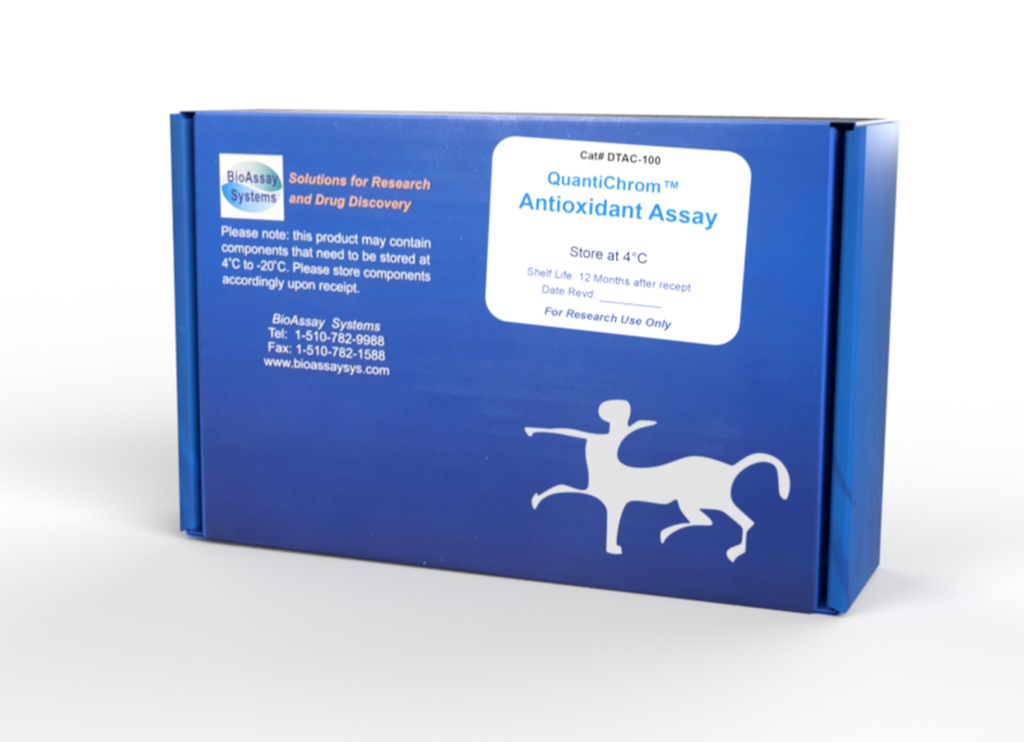DESCRIPTION
An ANTIOXIDANT is a molecule capable of slowing or preventing the oxidation of other molecules. Antioxidants protect the cells from damages by reactive oxygen species which are produced in oxidation reactions in the cell. Antioxidants can be small molecules such as glutathione, vitamins, or macromolecules such as catalase, glutathione peroxidase. As oxidative stress contributes to the development of many diseases including Alzheimer's disease, Parkinson's disease, diabetes, rheumatoid arthritis and neurodegeneration, the use of antioxidants in pharmacology is intensively studied. Antioxidants are also widely used as dietary supplements and in industry as preservatives in food, cosmetics, rubber and gasoline.
Simple, direct and high-throughput assays for total antioxidant capacity (TAC) find wide applications in research, food industry and drug discovery. BioAssay Systems' improved assay measures total antioxidant capacity in which Cu2+ is reduced by antioxidant to Cu+ . The resulting Cu+ specifically forms a colored complex with a dye reagent. The color intensity at 570nm is proportional to TAC in the sample.
KEY FEATURES
Sensitive and accurate. Use 20 µL sample. Linear detection range from 1.5 to 1000 µM Trolox equivalents.
Simple and high-throughput. The procedure involves addition of a single working reagent and incubation for 10 min. Can be readily automated as a high-throughput assay for thousands of samples per day.
APPLICATIONS
Direct Assays: serum, plasma, urine, saliva and other biological samples, food and beverages.
Drug Discovery/Pharmacology: effects of drugs on TAC.
KIT CONTENTS
Reagent A: 12 mL Reagent B: 1 mL
Standard: 100 µL 50 mM Trolox
Storage conditions. The kit is shipped at room temperature. Store all components at -20 °C. Shelf life of six months after receipt.
Precautions: reagents are for research use only. Normal precautions for laboratory reagents should be exercised while using the reagents. Please refer to Material Safety Data Sheet for detailed information.
SAMPLE PREPARATION
Samples should not contain any metal chelators (e.g. EDTA) and should
be clear and free of any turbidity or particles. Liquid samples (e.g. nonhemolyzed serum, plasma) can be assayed directly. Cell lysate is
prepared by homogenizing or sonicating cells in ice-cold 1 x PBS and
centrifugation for 10 min at 14,000 rpm to pellet any debris. Use the clear
supernatant for the assay. If not assayed immediately, freeze
supernatant at -80°C (stable for 1 month).
ASSAY PROCEDURE
1. Standards and Samples. Equilibrate all components to room temperature. Briefly centrifuge Reagent B and Standard before opening.
Mix 5 µL of the standard with 245 µL dH2O (final 1 mM Trolox). Dilute standards as shown in the Table below. Transfer 20 µL standards into wells of a clear flat-bottom 96-well plate.
Transfer 20 µL of each sample into separate wells of the 96-well plate.
Note: for unknown samples, perform several dilutions to ensure that TAC is within the linear range of 1.5 to 1000 µM Trolox equivalents.
2. Assay. Prepare enough Working Reagent for Sample and Standard wells by mixing, for each assay well, 100 µL Reagent A and 8 µL Reagent B. Add 100 µL Working Reagent to all assay wells. Tap plate to mix. Incubate 10 min at room temperature.
3. Read OD570nm on a plate reader.
Note: if calculated TAC is higher than 1000 µM Trolox equivalents, dilute sample in dH2O and repeat assay. Multiply the results by the dilution factor.
CALCULATION
Subtract blank OD value (#4) from all standard and sample OD values. Plot the ∆OD570nm against standard concentrations and determine the slope of the standard curve. Calculate the Total Antioxidant Capacity (TAC) of Sample,
ODSAMPLE and ODBLANK are the OD570nm values of the sample and H2O blank (standard #4). n is the sample dilution factor.
MATERIALS REQUIRED, BUT NOT PROVIDED
Pipetting devices, centrifuge tubes, clear flat-bottom uncoated 96-well plates, plate reader capable of reading optical density at 570nm, homogenizer or sonicator etc.
PUBLICATIONS
1. Vieira da Silva, I et al. (2021). Glutamine and cystine-enriched diets modulate aquaporins gene expression in the small intestine of piglets. PloS One, 16(1), e0245739.
2. Rishi, P et al. (2017). Better management of alcohol liver disease using a 'Microstructured Synbox' System comprising L. plantarum and EGCG. PloS one, 12(1), e0168459.
3. Villa-Bellosta, R. et al. (2017). Novel phosphate-activated
macrophages prevent ectopic calcification by increasing extracellular
ATP and pyrophosphate. PloS one, 12(3), e0174998.
